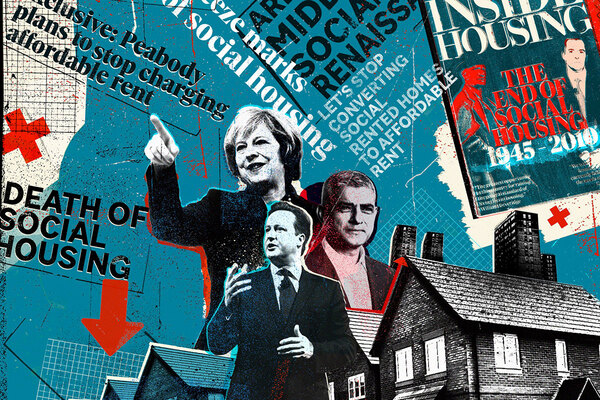You are viewing 1 of your 1 free articles
The opaque art of rent setting: London Affordable Rent explained
How rent is calculated and how much should be paid is not as clear as it could be. Gavriel Hollander investigates
Since the introduction of affordable rent as a tenure in 2010, the proliferation of different rental products has done little to clear the muddy waters of rent setting.
Peabody’s decision to freeze or cut rent on around 4,000 of its homes has thrown a spotlight on one of these tenures in particular: London Affordable Rent (LAR).
It is to this tenure that Peabody will reduce some of its homes currently let at affordable rent, once those homes become void.
LAR was introduced by mayor Sadiq Khan as part of his 2016 Affordable Homes Programme (AHP).
In the following year’s draft housing strategy for London, the new product was described as being “based on social rents”.
This sets it in contrast with the affordable rent tenure brought in by the coalition government of 2010 which, famously, pegged rents at up to 80% of market prices.
How LAR works in practice is that the mayor sets a ‘benchmark’ rent that caps how much social landlords can charge for each type of property. This is then increased annually, based on the Consumer Price Index. Landlords can also still charge less than this benchmark.
One London rental expert tells Inside Housing that the LAR is, in effect, a means by which housing associations can apply for grant for social rented homes while still coming under the auspices of the AHP.
"Views suggest that LAR is a back-door way to return to social rent"
Or, as Peabody chief executive Brendan Sarsfield put it on Inside Housing’s podcast last week, it’s “social housing plus a tenner”.
Both views suggest that LAR is a back-door way to return to social rent.
Mr Sarsfield is quick to acknowledge that the reality of LAR is actually “more nuanced than that”, but it is also in some cases likely to be considerably more expensive, depending on how close to the benchmark Peabody and any others who follow its lead decide to set rents.
The 2018/19 benchmark for bedsits and one-bed homes is £150.03 a week, for two-beds it is £158.84, while three-bed homes on the tenure will pay a maximum of £161.67.
The benchmarks are set London-wide, rather than by borough, meaning they are relatively crude, but they are nevertheless clearly some way below most homes in the private rented market.
They are, however, significantly north of social rents in the capital.
In 2016/17, the latest year for which figures are available, the average social rent for homes let by housing associations in London was £124.07. For local authority-let homes, the figure was £108.06.
Although these figures do not take into account two years’ worth of inflation-based uprating, they are also an average across all types of housing, meaning homes with fewer bedrooms are likely to be cheaper still.
"Residents of similar properties are still left paying vastly different rents"
The good news for tenants currently enjoying cheaper social rents is that another part of the mayor’s housing strategy prevents these homes being converted to affordable rent, something which was permissible under the previous regime.
But that still leaves residents of similar properties paying vastly different rents – and leaves a sector with little clarity over how best to balance fairness to its tenants with safeguarding what is still, by far, its biggest income generator.
“The whole thing is a bloody mess,” says Greg Campbell, a partner at housing consultant Campbell Tickell.
“It is getting more and more complicated as time goes on, not least because of the complex way a number of organisations [are] going in different ways in terms of what rent they charge.”
In some ways, Peabody’s move is a step towards untangling that “bloody mess”. The 55,000-home association morphed into its current guise last year when it merged with Family Mosaic.
One of the complications of the merger was that the two legacy organisations had very different rent-setting models.
While the majority of older Peabody stock was still at social rent, it had developed homes under the government’s Affordable Homes Programme at much closer to the 80% of market limit than its merger partner had. For its part, Family Mosaic set its own cap of 65% for any homes built under the AHP.
Indeed – and to add to the linguistic confusion on rents – Family Mosaic’s 2017 annual report describes its 18,000 general needs homes as “rented social housing”.
On the ground, this means tenants of the same landlord in the same area are being charged very different rents.
"Mr Sarsfield describes it as a “small step” and says he can’t do more unless the government offers associations more freedom to charge their own rents"
In Lambeth, for example, Family Mosaic and Peabody tenants in a two-bed social rented flat in 2016/17 were paying £120.81 and £124.10 respectively. However, those in similar affordable rent flats were paying £137.85 as Family Mosaic tenants, but £210.23 under Peabody.
Understandably, the policy, announced last week, applies only to some of those legacy Peabody tenants currently paying more than their Family Mosaic counterparts.
Mr Sarsfield himself describes it as a “small step” and says he can’t do more unless the government offers associations more freedom to charge their own rents within a “rental envelope”.
But the association’s decision to take matters into its own hands might not be universally applauded, even if it does create more fairness.
“I don’t suppose government wants to see [housing associations having] more autonomy,” suggests Richard Petty, head of affordable housing at JLL. “If the government loses control over rents, they would need to rewrite the rules, and they don’t want to do that.”
At a glance: the different types of rent in London
Picture: Getty
Social rent: The amount of social rent a person pays depends on the location and size of the property, and is set according to a complex formula, but it is typically set at between 50% and 60% of market rent.
Affordable rent: Introduced by the coalition government in 2011, ‘affordable’ rent can be up to 80% of market rent, although many associations have been charging lower than this.
London Affordable Rent: A tenure introduced by Sadiq Khan that is lower than national affordable rent and based on target rent levels towards which social rents are gradually being raised. This makes it higher than average social rents in the capital, but in line with the rent that would likely be charged if a new social rent unit was built and set according to the same formula.
London Living Rent: A rental product aimed at middle-income Londoners introduced by Sadiq Khan, with rents set at one-third of average local earnings.
Target rent: A social rent level calculated by the government, which council and housing associations should use to move their social rents to over time.
More episodes of The Housing Podcast
Review of the year 2019
As the year draws to an end, The Housing Podcast team wraps up the last 12 months, battles it out in a housing quiz, and looks ahead to 2020.
What did the Grenfell Inquiry phase one report say?
This week, Sir Martin Moore-Bick published his Phase One report from the public inquiry into the Grenfell Tower fire in June 2017. The 838-page report focuses on the events of that dreadful night: how the blaze started, how it spread so ferociously through the building, and how organisations including the emergency services responded.
Sir Martin has also produced recommendations aimed at preventing similar disasters from happening again. Our team has spent the last few days picking through the report, and in this episode of The Housing Podcast, we discuss the key points.
As Boris Johnson takes over at Number 10 Downing Street and appoints his new cabinet, the Housing Podcast team present their first ever 'emergency' episode, looking at whether he is set to shift the housing policy dial back towards home ownership.
The Homes Fit for Human Habitation Act is on the statute book. But what is it for? What does it do? And will it work?
Karen Buck MP, who guided the bill through parliament, along with housing lawyers Giles Peaker and Justin Bates – who wrote it – sit down with The Housing Podcast to answer all this and more.
Theresa May scraps the cap: what does it mean?
To the delight of councils across the country, Theresa May announced this week that she will scrap the Housing Revenue Account borrowing cap.
With the help of Eamon McGoldrick of the National Federation of ALMOs, in this week’s episode of The Housing Podcast we discuss the history of this contentious area of housing policy and look at what happens now.
The true cost of homelessness
Inside Housing has conducted in-depth research into the amount councils are spending on temporary accommodation for homeless people, with shocking results.
In this episode of The Housing Podcast, we take a look at the financial aspect of homelessness and discuss the figures with Matt Downie, director of policy and external affairs at Crisis.
Rating the Social Housing Green Paper
The Housing Podcast team is joined by David Pipe from the Chartered Institute of Housing and housing columnist Jules Birch to rank the proposals in the Social Housing Green Paper out of 10. Edited by Luke Barratt.
Listen or download here:
The supported housing saga
The government’s announcement this week that it will drop plans to change the way supported housing is funded brings to a close a nearly three-year cycle of lobbying against these proposals.
This week, The Housing Podcast looks back at this story, which began with a throwaway line in George Osborne’s Autumn Statement in 2015.
A brief history of council housing
In this week’s episode of The Housing Podcast we speak to John Boughton, social historian and author of Municipal Dreams: The Rise and Fall of Council Housing, about the five phases of local authority housing – starting in the East End of London in 1900.
Who has been the best housing minister since 2010?
The Housing Podcast team gets together to rank all the housing ministers of the modern Tory era, from Grant Shapps to Dominic Raab. There are a lot of them. Edited by Luke Barratt.
Listen or download here:
The Hackitt Review
This week, Dame Judith Hackitt released the findings of her building regulations review, commissioned by the government in the wake of the Grenfell Tower fire last June.
Featuring an interview with Dame Judith, the team takes a look at what was in the report – and why some people were less than impressed.














